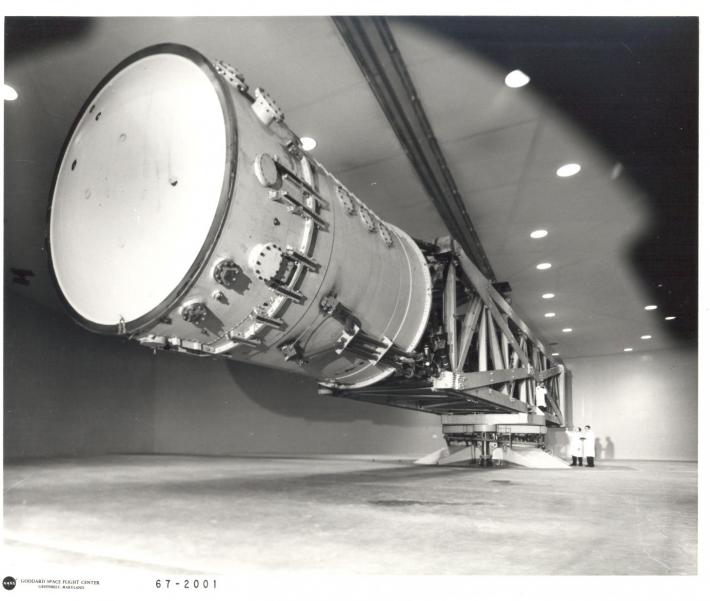
GPM Takes a Spin on the Centrifuge (page 2)

NASA technicians spun the GPM satellite up to just over 10 RPM in Goddard Space Flight Center’s High-Capacity Centrifuge facility March 31 2011.
Put Some Spin On It
If you've ever taken a fast curve in a car, you've felt your body pushed outward, away from the curve. That outward push is centrifugal force, and the faster you turn, the more it pushes you away from the center. Spinning on the centrifuge does the same thing to the satellite -- except the centrifugal forces are a lot bigger -- capable of going up to 30 times the force of gravity, or "g's." GPM's test went up to seven g's.
But simply spinning the spacecraft isn't enough. The g forces only push outward, and the engineers need to test the satellite from all directions to see how the metal frame and the bolts that hold the parts together withstand the stress. So the test actually consisted of five separate centrifuge runs, each with the spacecraft in a different orientation.
If the satellite were a person the blocky instrument mock-ups would be GPM's belly and the upper bus its spine. During one run, GPM faced the center of the centrifuge, and its belly pushes outward and the upper bus spine pulls away. The next orientation had GPM turned 90 degrees to face the direction of spin -- the car scenario -- where its inside shoulder pushed outward on the shoulder next to the wall.

Credit: NASA Goddard
But in a vertical position, the centrifuge can't test what would happen if a force pushed the satellite straight down.
"Imagine a spacecraft launching," said Bill Chambers. The largest force on the spacecraft will be a compressive force pushing down on its head as the rocket breaks free of Earth's gravity, he said. To simulate that compressive force on the centrifuge, they tilt the satellite.
That specially-designed fixture that held the spacecraft to the platform can not only rotate the satellite, but also tilt it -- outward toward the wall, creating a stretching force, or in toward the center, creating a compressive force.
The GPM engineering team carefully calculated what the forces should be for each inch of the spacecraft before the test. It's not simple, said GPM project manager, Art Azarbarzin at NASA Goddard. This essential test of the GPM Core satellite was also unusual because the engineers decided to use the centrifuge instead of other testing methods.
The same forces can be reached in a static test by tilting the satellite in different orientations and using a machine called a hydraulic actuator to put weight on different points. If you do this once, this test is cheaper than one run on the centrifuge. But for GPM to get the equivalent g's, the testing would have taken a time consuming 20 configurations, said GPM's chief mechanical engineer Jay Parker at NASA Goddard. "I probably saved a quarter of a million dollars by doing the testing on the centrifuge," he said.
Centrifuge Control – Accepting all Orientations
For every orientation of the satellite, each test started out slow with the centrifuge spinning at 10 percent of full speed. Data streamed into the control room from the 120 sensors. The sensors are strain gauges, Chambers said, "little tiny things that look like a piece of copper foil." Each sensor has two pieces of metal with an electrical resistor in-between. They’re glued to the satellite’s metal frame, and as the metal stretches or compresses, the electrical signal from the gauge changes -- indicating the g forces pulling on the satellite.
Hunched over their laptops, GPM project engineers compared the strain gauge data to their predictions. If the data looked good, they gave the thumbs up to Don Benner, project engineer for the centrifuge test group. He ramped up the speed in ten percent intervals. At 40 percent of full speed, Benner took the centrifuge back down to zero and everyone went back into the chamber to visually inspect the satellite to see how it was doing. When it checked out, they closed back up and it was full speed ahead.
Ultimately, GPM had between 3.0 to 6.2 g's of force put on it, depending on its orientation. "It was a very successful test," said Parker. The satellite "behaved as predicted, which is always a good thing." The entire spacecraft structure passed and qualified for flight.
After three dizzying days in Building 15, the mock-ups were unbolted and GPM's upper bus was sent off to the clean room where it was fully integrated with the lower bus and propulsion sections of the spacecraft in May, 2011.
Article By: Ellen Gray
Originally Posted on www.nasa.gov
NASA's Goddard Space Flight Center, Greenbelt, Md.

